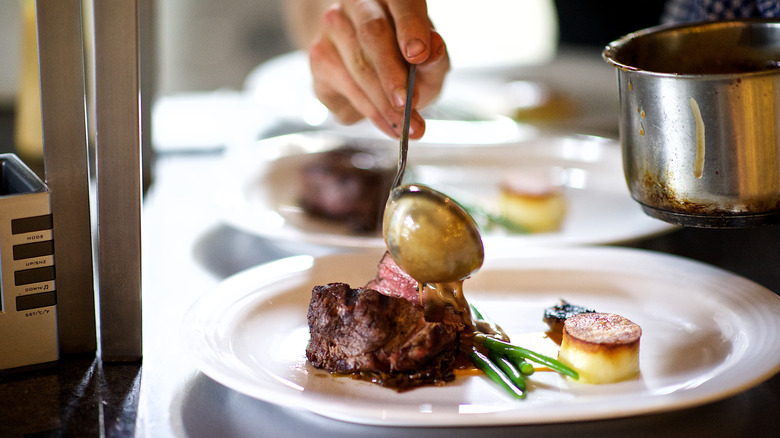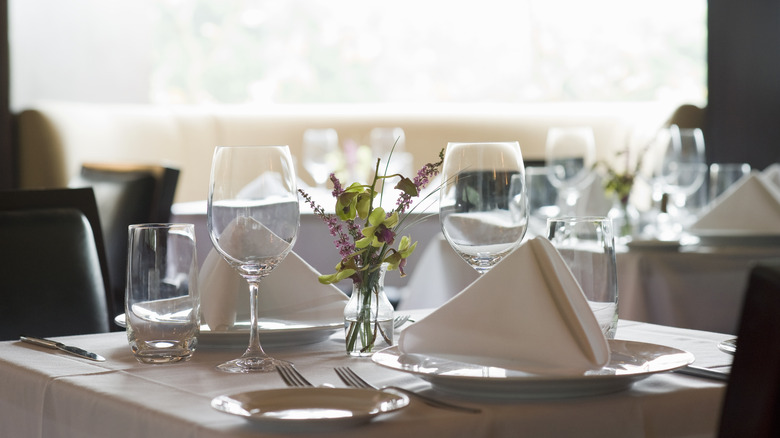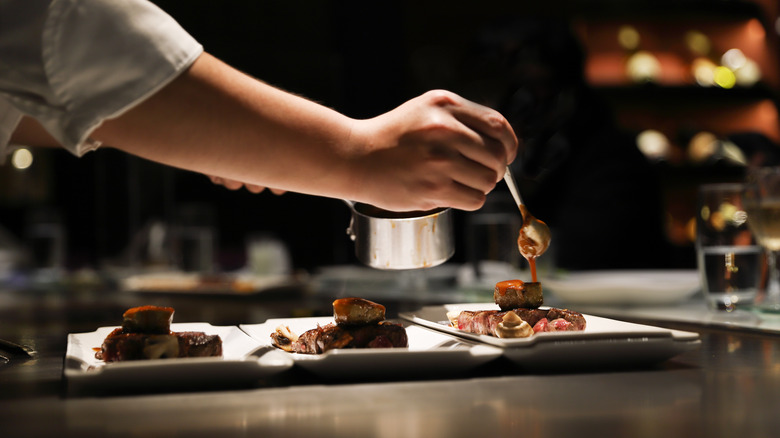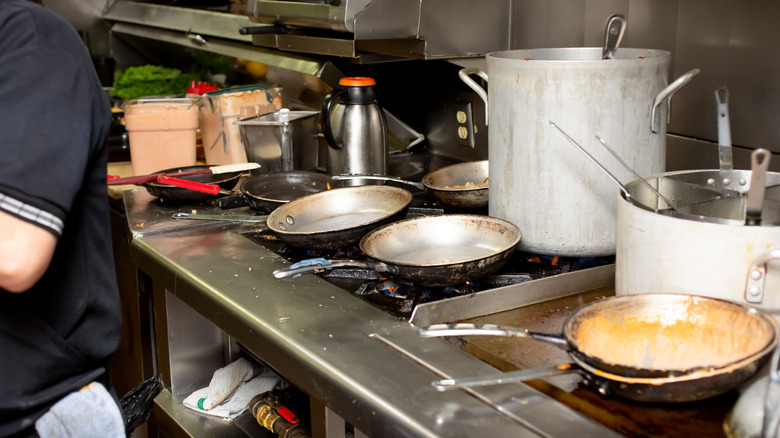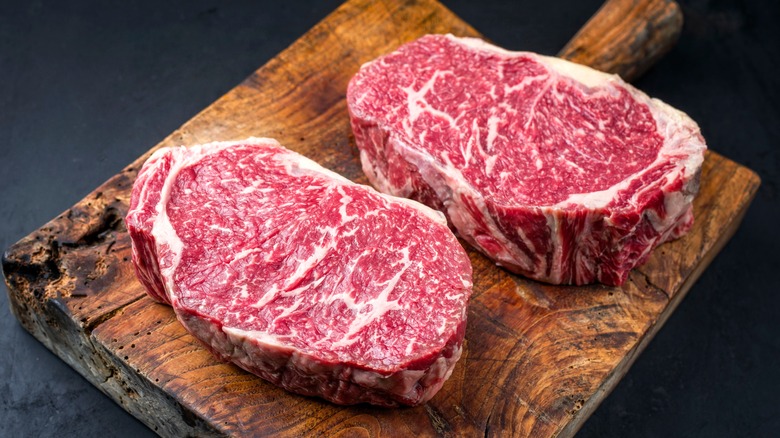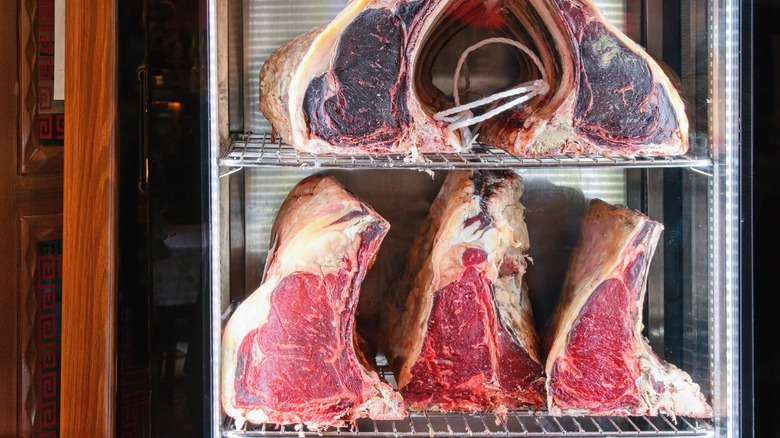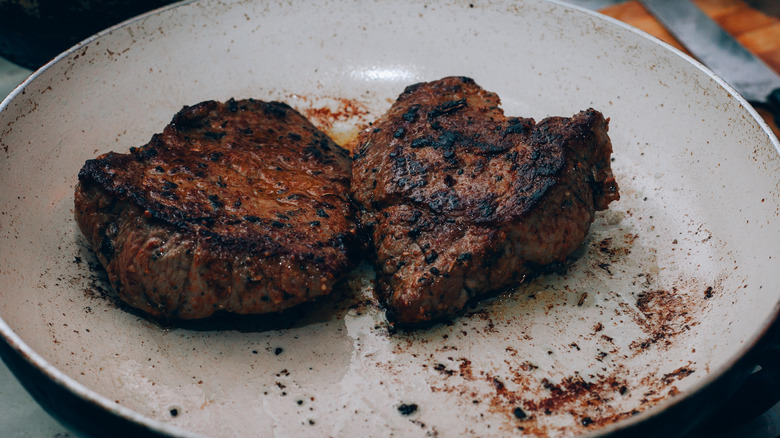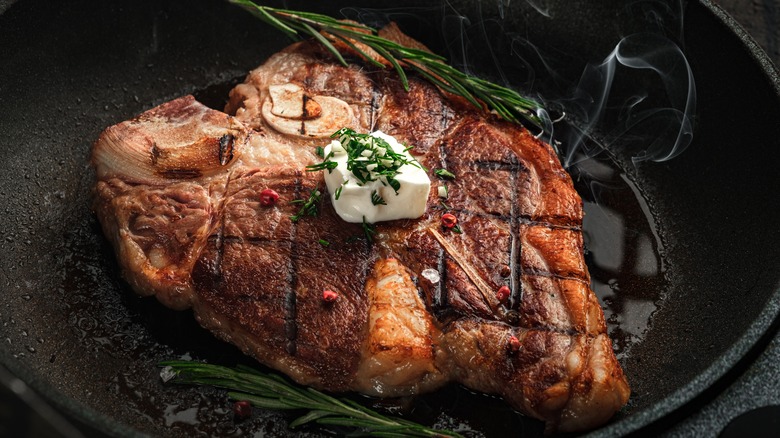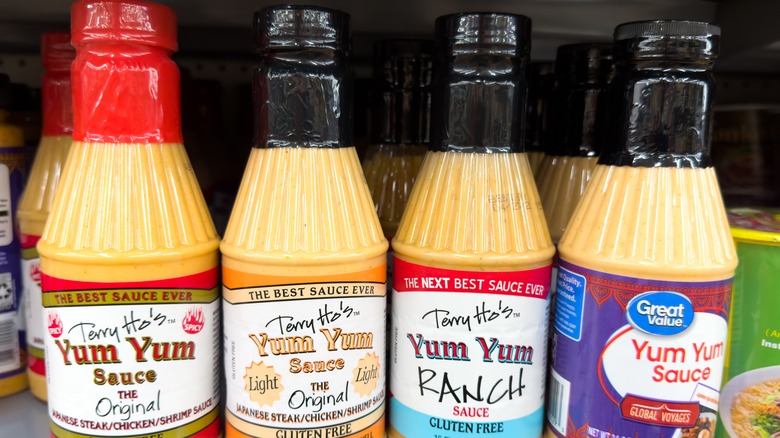Experts Explain The Red Flags You Should Watch Out For When Dining At A Steakhouse
When visiting a steakhouse, most diners hope for a refined yet relaxed ambiance and a chance to sample premium cuts of meat. You'll find different styles of steakhouse depending on what type of cuisine they serve — for example, Brazilian steakhouses differ from ones in the U.S. as they usually carve different meats rodizio-style at your table from a freshly grilled skewer.
No matter what kind of steakhouse you visit, though, the meat is the centerpiece of your meal. It should be perfectly cooked, with everything else on your plate working to support its flavors. Mouth-watering sides and sauces and a sophisticated drinks selection are also crucial.
With so many steakhouses out there, it can be hard to know whether you're walking into a foodie's fantasy or a fine dining nightmare. To gather some more info on how to choose a great steak restaurant — and what to avoid when picking one — we spoke to four industry experts. These steakhouse pros gave us a list of some major red flags that would send them running for the door. From low-quality meat to lackluster service, knowing these signs could help you become a steakhouse connoisseur.
There's a ton of last-minute availability
According to Alexander Link, General Manager at the Final Cut Steakhouse inside Hollywood Casino at Charles Town Races, a quality steakhouse should never be deserted at peak times. Link notes that, "if you can get a reservation on a Saturday at 6 p.m. it's probably not a great choice." Peak times in most restaurants include evenings from 6-9 p.m. and lunchtimes between 12-2 p.m. It's wise to make a reservation at least a few days in advance to have the best shot at a good table and ensure that you won't have any extra limits on your seating time.
Beyond showing that a steakhouse is not very popular, a lack of other diners can also lead to a flat, dead atmosphere. There's nothing worse than awkwardly eating your meal while the staff keeps the place open just for you. While it's fine to try your luck and go for a last-minute walk-in, you should still aim for a steakhouse that looks bustling and expect a short wait for a table.
Pictures on the menu are a major red flag
Putting pictures on the menu is standard in some restaurants and is not necessarily a mark of poor quality. For instance, it's common at many Thai restaurants to have photos of the food on the wall or the menu, and it's also common at higher-quality fast-food chains. Photos on a steakhouse menu, however, are considered a major no-no. Alexander Link explains that, "a good steakhouse should be elegant and classy, and the menu presentation should match this."
You should also watch out for steakhouses with cheap-looking or cheap-feeling menus — sticky, laminated menus or shabby paper menus are classic steakhouse red flags. Another red flag is a menu that is confusing and difficult to read. Ideally, a steakhouse menu should look aesthetic and appealing, with concise yet informative descriptions of each dish. Not having prices on steakhouse menus is also a red flag as it does not allow the customer to make an informed choice about their meal and can feel stressful for those on a budget.
A large menu could be a sign of low quality
A massive, eclectic menu can be a red flag at any restaurant. Having too much choice on offer suggests that the kitchen focuses on quantity over quality rather than perfecting a few, well-thought-out dishes. Luis Mata, Co-founder of Meat 'N' Bone, notes that "when assessing a restaurant [you should] always pay close attention to the menu" as a gauge of quality.
Very large menus can also be overwhelming to customers and can hinder them from comfortably making a decision. You don't want to feel pressured because your server is waiting and end up ordering something you didn't really want.
Mata observes that a very small menu is often preferable to a large menu at steakhouses. He says, it's better to "eat at a steakhouse that does a few dishes exceptionally well, using high quality ingredients, than one that has pages of menu options." Having a large menu also increases the chance that the kitchen team may not be as skilled at making every dish to the high quality you expect from a steakhouse.
Prices should reflect the food quality
According to Alexander Link, customers should expect to pay slightly more at steakhouses than they would at other restaurants. Link points out that steakhouses "should be expensive since the menu is commodity price and protein driven [and so] have smaller margins than any other style of dining." Steakhouse menus are fundamentally tied to the price of cattle, which leaves them vulnerable to price fluctuations in this market.
Due to the time and resources that go into raising cattle, as well as lengthy preparation processes like dry-aging, steak prices tend to be even higher than other proteins, leading to steakhouse prices that reflect this. If you notice that a steakhouse is offering much lower prices than its competitors, it's probably cutting costs somewhere — usually in the beef quality. Butchers can only get tender steak cuts out of 10-12% of a cow's body, making cuts like rib-eye and tenderloin scarcer and more expensive.
On the other hand, high prices on beef can also lead to steakhouses raising prices in other areas — such as on sides or drinks — as customers are already expecting to pay a lot to dine there. A good steakhouse will meet its margins by charging appropriately for high-quality steaks without putting extortionate prices on supporting items. Watch out for steakhouses that push bottled water — this is the reason water isn't usually free in European restaurants – or that don't offer any free sides with any entrees.
The restaurant is messy
Poor cleanliness should always make you think twice before dining at a restaurant. Jessica Chantilly a former chef and food blogger at Jecca Chantilly, stresses that diners should pay attention to details when choosing somewhere to eat. Messy areas throughout the restaurant, such as "cluttered entrances, dirty tables and floors, dusty light fixtures, and messy restrooms are all signs the restaurant has poor hygiene practices." You can even look out for signs of slack health and safety standards before you enter, such as a junk-strewn parking lot or dirty windows and doors, which suggests that staff don't often clean up.
Marks on cutlery or fingerprints — or, even worse, lipstick stains — on glasses should make you immediately re-evaluate your steakhouse choice. The same goes for messy service areas, such as the bar or condiment stand, especially when the restaurant is quiet and there are plenty of staff around. A lack of care by the front-of-house team often suggests a lax approach to hygiene that could easily carry over into the kitchen.
As with all restaurants, steakhouse kitchens should be kept pristine due to the presence of raw meat alongside cooked ingredients. Poor hygiene in a steakhouse kitchen is not only a risk to your health but also impacts the quality of the food. Just as you should be cleaning your grill after every use at home, grime build-up on restaurant grills can seriously taint meat flavor.
The servers are poorly informed
Rude, chaotic, or slow service can put you off a restaurant before you've even tried the food. However, seamless service is even more important in a steakhouse because it often specializes in premium products. Most customers do not know much about the beef industry, so it's crucial that knowledgeable servers are on-hand to walk diners through the menu.
Luis Mata notes that servers should display in-depth knowledge about the steaks and where they come from. If your server can tell you "the names of the farms or programs, the grading of Wagyu steaks, and even the selection of steak cuts [then this] all speaks volumes about the restaurant's dedication to excellence."
Mata adds that this is particularly important at steakhouses that serve USDA-grade steaks and above. USDA steaks are graded according to the amount of marbling or fat they contain, which enhances the flavor, and the cow's age when it was slaughtered — usually, the younger the beef, the higher the grade. Wagyu steaks, which traditionally hail from a cattle breed in Japan, are graded higher than USDA prime and choice cuts because they are densely marbled, leading to a succulent texture and flavor. Servers should also be able to answer any questions about side dishes, drinks, allergy information, and any dry-aging, cooking, or tenderizing techniques that the steaks undergo.
The steaks are badly trimmed
According to Sean Thompson, Executive Chef at Porter House and Grill in New York's Columbus Circle, poorly trimmed steaks are a sure sign of a low-quality steakhouse. Steak cuts often need to be trimmed before cooking to remove excess fat and prevent the steak from curling or drying out. While marbling is good fat that runs through the center of the steak, fat around the outer edges shrinks as it cooks and can squeeze the meat. pressing out the juices.
Thompson notes that "strip steak with insufficient trim" is a notorious sign of a bad steakhouse. A well-trimmed strip steak will still have a rind of fat on its outer edge but that will be cut before cooking, meaning that it will split as it cooks rather than squeezing and drying the meat.
Another major trimming red flag that Thompson points out is "a filet that's not a center cut, or a filet where part of the chain is used." A filet mignon is the very end of a beef tenderloin — a thick, cylindrical cut of meat located between the sirloin and the top sirloin – and is known for being melt-in-your-mouth tender when properly prepared. The chain, a connective strip of fat that runs along the tenderloin and connects to the filet mignon, should be fully removed before cooking. Although meat from the chain can be used in other dishes, it is lower-quality meat than a filet mignon and can be tough and chewy.
Lack of signature preparation methods
As well as emphasizing high-grade cuts, Jecca Chantilly observes that "a good steakhouse usually highlights its signature preparation methods, such as dry aging, wet aging, and grilling techniques." If all the steaks are cooked the same way or there is a lack of information about preparation techniques on the menu, this could be a red flag. Dry-aging steak is popular among high-end steakhouses and results in super tender meat with tons of punchy, umami flavor. Many steak restaurants will dry-age meat in-house, leaving the beef to hang in a tightly controlled, dry climate to help break down the muscle fibers and semi-ferment.
Wet aging is also a popular technique and involves aging steaks in vacuum-sealed packs. This keeps the juices inside and gives the steak a tender, mildly fermented taste. Some high-end steakhouses also butcher meat in-house to ensure diners get tender cuts.
Most top-tier steakhouse menus will emphasize not only the beef's origins and grade but also the signature preparation techniques. These methods are often the reason steak tastes different at a restaurant than it does when you make one at home as the meat has been primed to have more flavor.
Your steaks are overcooked or underdone
Jecca Chantilly states that, when it comes to dining at a steakhouse, "The proof is in the steak. Steaks that are served overcooked or undercooked are a major red flag because it demonstrates a lack of skill." Servers should always ask how you want your steak cooked and should be able to confidently advise you based on the cut.
Steaks are generally cooked one of several ways — blue, rare, medium rare, medium, medium well, and well done. While every restaurant may have a slightly different metric for this, some recognizable industry standards exist. Blue steak is always served fully raw and cold in the center, with just a light sear on either side. A rare steak, meanwhile, is cooked for slightly longer to brown the outside but still has a red interior with an internal temperature of about 125-130 degrees Farenheit.
Steaks that are cooked medium and above should have a firm, springy texture and a warm interior of at least 140 degrees Farenheit. If you have a lot of experience eating steak, you'll be able to tell if your steak is properly cooked by its color and texture — it's part of the reason restaurant lighting affects the dining experience more than you think as it's important to clearly see your food. If you've not eaten much steak before, it may be best to start with medium and then work up to trying rarer cuts.
Steaks are under-seasoned or lack flavor
Flavorless steaks are always a red flag in a steakhouse as it suggests that the restaurant has no idea how to prepare its signature product. Lack of flavor on steaks can be caused by low-quality meat, lack of preparation, or a failure to salt and season food properly. For certain preparations, a good steak chef will coat a steak in salt prior to cooking it and leave it to rest. Some chefs salt steaks and leave them overnight, while others add salt around 40 minutes before the steak hits the pan.
Salting the outer surface of the steak allows the flavor to penetrate the inside of the meat and activates the juices. These juices flow to the surface and then get reabsorbed, carrying the salt flavor through the meat. Steaks that have been poorly prepared may be overly briney or may completely lack flavor. If the juices have not been left long enough to properly reabsorb, too much juice can also pool in the pan, preventing the hot sear that browns the meat and adds flavor to your beef.
Sean Thompson adds that it's also a red flag if steakhouses go overboard with other seasonings. When it comes to steak, he says, "simplicity is best. At most, a watercress salad and some veal jus or maître d'hôtel butter" should be used.
Too much emphasis on condiments or sides
From creamy peppercorn sauce to a crunchy half-lettuce drizzled with honey and mustard dressing, the sides can be all part of the fun when you're eating at a steakhouse. However, if it feels like there's more information about the sides than the steaks on the menu or if the servers heavily upsell condiments or toppings area big red flag.
According to Luis Mata, "a high-quality steak and a chef who knows how to cook it to perfection should speak for itself." Diners should avoid covering their steak in sauce before they've tried the meat as the flavor is meant to be experienced and, to an extent, to stand alone. A sub-standard steakhouse will use sauces and condiments to cover up poor-quality meat and to compensate for mishandled seasoning. Bottled sauces at a steakhouse can also be a major red flag.
Not enough choice on the drinks menu
To complement your steak, it's important that your chosen steakhouse has a well-stocked bar and a high-end drinks selection. Alexander Link warns that it's a red flag if a steakhouse does not have a "cocktail bar manager and a sommelier on staff." A skilled steakhouse sommelier has a thorough understanding of both the wine list and the food menu and can easily guide diners to a vintage that will enhance their meal. The sommelier will also seamlessly handle any problems with your wine — if you want to know the proper way to send back a bottle of wine at a restaurant, it's advisable to let the sommelier taste the wine so you know whether it is corked or not.
Similarly, many high-end steakhouses offer a signature or classic cocktail selection and have skilled mixologists manning this station. Popular cocktails that pair well with steak include strong, whisky or bourbon-based blends, like an old fashioned or a whisky sour. A bloody mary also works well, as the tangy and smooth tomato flavor can cut richness.
